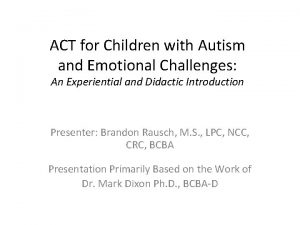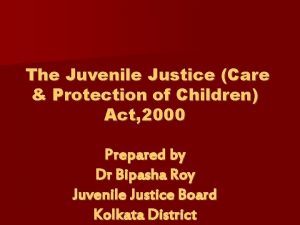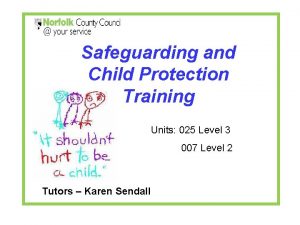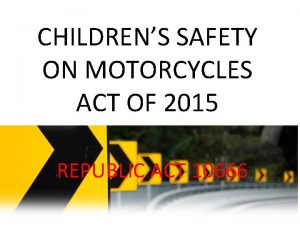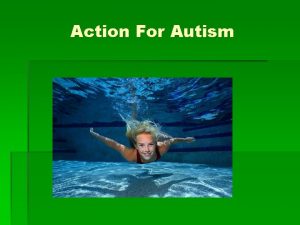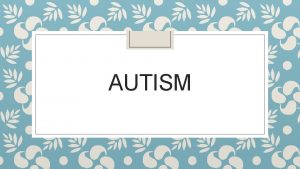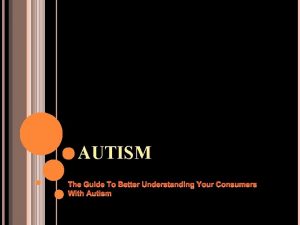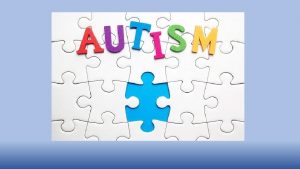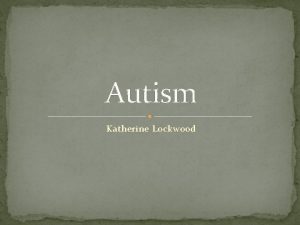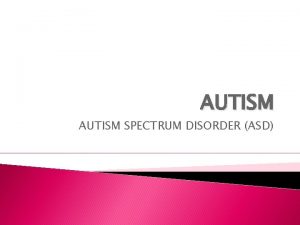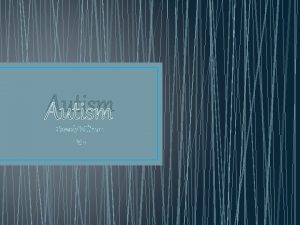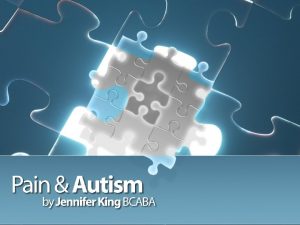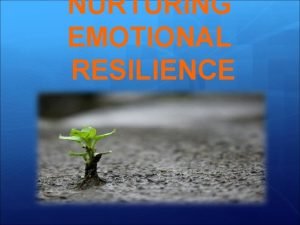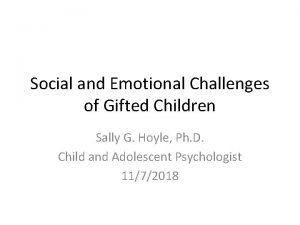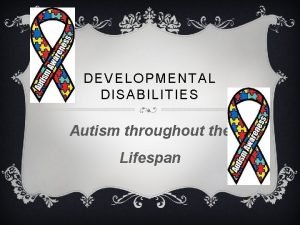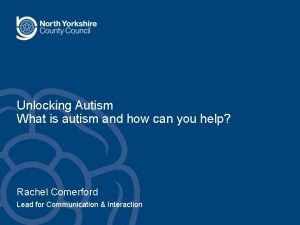ACT for Children with Autism and Emotional Challenges










































- Slides: 42

ACT for Children with Autism and Emotional Challenges: An Experiential and Didactic Introduction Presenter: Brandon Rausch, M. S. , LPC, NCC, CRC, BCBA Presentation Primarily Based on the Work of Dr. Mark Dixon Ph. D. , BCBA-D

ACT for Children with Autism and Emotional Challenges: An Experiential and Didactic Introduction • NOTE: This presentation will not be providing BCBA CEUs

What Professionals Are Here? • • • Parents Behavior Analysts Teachers Counselors Social Workers Psychologists Residential Managers Case Managers Paraprofessionals

About the Presenter • Brandon Rausch, M. S. , BCBA, has worked in a variety of service settings within behavior analysis including acquired brain injury, early intensive behavioral intervention, developmental disability, organizational behavior management, and mental health treatment. His current interest is in applying clinical behavior analysis to address the issues of typically developing adolescents and adults. He is a member of the Association of Behavior Analysis International and the Association for Contextual Behavioral Sciences and was a past director of the South Dakota Association for Behavior Analysis. Mr. Rausch is also a Licensed Professional Counselor in the state of South Dakota and holds credentials as a Nationally Certified Counselor and Certified Rehabilitation Counselor.

Objectives Identify the Goal of ACT Identify the 6 processes of ACT Describe the connection to behavior analysis Review the evidence base for ACT Identify who ACT may be useful for and possible limitations • Participate in experiential exercises related to each ACT Process • • •

This Presentation is Based on

A Note on Terminology • It’s OK to feel uneasy about some terms – Psychological = behavioral – Mind = behavioral repertoire – Thoughts, feelings, sensations, urges = private events – Values = motivational augmental (rule governed behavior) – Mindfulness = might be useful to conceptualize as an attending skill

What is ACT? • Based in behavioral sciences and specifically applied behavior analysis • The House of ACT – Acceptance and Commitment therapy – Relational Frame Theory (next slide) – Applied Behavior Analysis – Functional Contextualism

Relational Frame Theory • Behavior analytic theory of language and cognition • Exercise: – Find any object in the room – Find another object • • • How are they alike How are they different How is the first object not the second object How is the first object better How is the first object worse • Humans are unique in that we can relate information along properties that are not physical but “arbitrary”. • This is always happening, language is a blessing and a curse • ACT teaches individuals to drop out of the world of language as it relates to stressors of living in a conceptualized past and future and teaches us how to be aware of what is happening right now

What is ACT? • Goal of ACT – Create a rich, full, and meaningful life while accepting the pain that inevitably goes with it – This is done by promoting “Psychological Flexibility” • Focus is on function and context (purpose and relationship) of thoughts, feelings, and behavior rather than the content (what it looks like) – This is different from traditional cognitive therapy that focuses on changing the content or frequency of certain thoughts

Six Core Therapeutic Processes of ACT (Useful to view these as equally important processes) • Defusion – (Notice your thinking) • Acceptance – (Willingness/open up) • Contacting the Present Moment – (Be here and now) • Self-as-Context – (Pure awareness) • Values – (Know what matters) • Committed Action – (Do what it takes)

Psychological Flexibility

Contrast with Psychological Inflexibility

Where Does ACT Come From? • ACT is a “Third Wave” Cognitive Behavior Therapy • The Cognitive-Behavioral Therapy tradition • “First Wave” = Behavior Therapy • “Second Wave” = Cognitive-Behavior Therapy • Closely related to other “Third Wave” CBT approaches • Dialectical Behavior Therapy • Functional Analytic Psychotherapy • Mindfulness-Based Cognitive Therapy • Mindfulness-Based Stress Reduction • Compassion-Focused Therapy

Does ACT Work? • “Evidence-Based Treatment” by Division 12 (Clinical Psychology) of the APA for: – – – Anxiety Depression Chronic Pain Obsessive-Compulsive Disorder Psychosis • Substance Abuse and Mental Health Services Administration (SAMHSA) recognized EBT for Substance Abuse • ACT’s base is Relational Frame Theory and is the foundation of PEAK. An early intensive behavioral intervention curriculum with the research supporting its effectiveness

PEAK • Relational Training Program – Extension of the Verbal Behavior approach – Composed of 4 modules • • Direct Training Generalization Equivalence Transformation – More on peakaba. com

Total Randomized Control Trials

Getting Into the Book • 180 lessons • Sample table of contents • Each activity is listed by: – Day – Title – Process Targeted – Type of activity

Reading the Activity Outline – Front 1) Day Number 2) Theme or Description 3) The ACT Process Targeted 4) Young Grade School 5) Older Grade School 6) Middle/High School

Reading the Activity Outline – Back 7) Day and Title 8) ACT Process 9) Experiential activity of the day

Additional Information • Some exercises require materials – Review the lesson before doing it • Setting implementation – Group or individual • Create a safe space – Allow the child to work through uncomfortable topics • Apply topics in the natural environment – Angry child wants to hit someone – defusion – Train for generalization • Who is this for – A child who can understand follow instructions – It is okay if this is new material or a little abstract

Defusion (from Thoughts) • Noticing thoughts as thoughts instead of truths • We are not trying to change the form or frequency of the thought • Thoughts are just words and do not define who you are • Examples: When was the last time you became stuck on rules, an event that happened, or something hurtful someone said to you?

Defusion

Defusion Discussion • Notice thoughts, but if you use emotions or sensations as an example that is OK • What are you noticing?

Acceptance (of Emotions) • Allows emotional responses to “happen how they happen” rather than try to deny them or make them different from what they are. • Think of a child you know – From an abusive background – With a family member in prison – With an intellectual disability • ALL children experience distressing thoughts • The older and the more cognitively developed the child gets the more they worry about fitting in • When was the first time you noticed feeling that you didn’t fit in? • When was the last time? • This teaches them the skill that they can feel an emotion without trying to change the emotion AND still do what’s important to them.

Acceptance

Acceptance Discussion • Try use emotions as an example, if another private event is used that is OK • What are you noticing?

Present Moment • Fully accepting what is going on in your environment without trying to change it • These are mindfulness skills - Paying attention, on purpose, in the present moment, nonjudgmentally • How often are you actually living in the here and now and not in an imagined future or constructed past? • I, Here, Now (deictic frame)

Present Moment

Present Moment Discussion • It is OK if your mind wanders. • The goal is not being perfect, but practicing • What are you noticing?

Self as Context • The concept of having a sense of self and realizing that our perception of self is often skewed as a result of the stories that we tell ourselves. 1. Conceptualized self - I am… 2. Ongoing self awareness – Monitors current thoughts and feelings 3. Observing self – the combination of the last two over time. E. g. Christmas tree • How do the kids you know handle labels others give them? Do they believe them? What labels did you believe from other people when you were a child?

Self as Context

Self as Context Discussion • This is a challenging concept. • This may make more emotional sense than rational sense. • What are you noticing?

Values • • Identifying and understanding your chosen life direction Often confused with goals Unlike goals, you can never check you values off a list Clear life directions you hold no matter what you feel on a given day. These are not what somebody else says they should be. Ask yourself, in this moment, are you moving closer to your values or further away. What does this look like in children? Justice for all? Or extra time at recess? Pick a reward! What do you want to earn? What’s important to you?

Values

Values Discussion • Useful to use different domains in life – – – – – Work Education Leisure Health and Self Care Spirituality Romantic Relationships Family Relationships Friendships Parenting Citizenship • What are you noticing?

Committed Action • Encourages behaviors that will help a person move towards chosen values • Short term and long term • Can check these off a list • Goals need to coincide with values • Think of a trip! Values are the direction, the goal is the destination • In children this may be trying and trying again

Committed Action

Committed Action Discussion • Be aware of barriers and plan for when they arise – Are these barriers internal or external? • What do you notice?

What did you notice? • Ending the exercise with a question about what was noticed can normalize the experience • Use “and” instead of “but” • Validate the experience

Useful resources • Happiness Trap – by Russ Harris – Lay-person read for personal development • Get Out of your Mind and Into Your Life – By Steve Hayes - Workbook for adults • ACT Made Simple – By Russ Harris – Basic skills training manual for therapists • Get Out of Your Mind and Into Your Life for Teens – by Ciarrochi, Hayes, and Bailey – Workbook for teens

References • • • American Psychiatric Association. (2013). Diagnostic and statistical manual of mental disorders (5 th ed. ). Washington, DC: Jaypee Brothers Medical Publishers. APA Presidential Task Force on Evidence-Based Practice. (2006). Evidence-based practice in psychology. American Psychologist, 61, 271 -285. Boone, M. S. , & Canicci, J. (2013). Acceptance and commitment therapy in groups. In Pistorello, J. (Ed. ). Mindfulness and Acceptance for Counseling College Students. Oakland, CA: New Harbinger. Clarke, S. , Kingston, J. , James, Bolderston, H. , & Remington, B. (2014). Acceptance and commitment therapy group for treatment-resistant participants: a randomized control trial. Journal of Contextual Behavioral Science. 3, 179 – 188. Dixon, M. (2016, June). Using RFT and ACT to Optimize Therapy for Individuals with Autism. ACBS International. Workshop conducted from Association for Contextual Behavioral Science, Seattle, MN. Dixon, M (2014). Acceptance and Commitment Therapy for Children with Autism and Emotional Challenges. Carbondale, IL: Shawnee Scientific Press, LLC. Harris, R. H. (2009). ACT made simple. New Harbinger Publications, Inc. Oakland, CA. Hayes, S. C. (2004). Acceptance and commitment therapy, relational frame theory, and the third wave of behavioral and cognitive therapies. Behavior Therapy, 35, 639 – 665. Luoma, J. B. , Hayes, S. C. , & Walser, R. D. (2007). Learning ACT. Oakland, CA: New Harbinger.
 Self as context
Self as context Macbeth act 2 summary
Macbeth act 2 summary Cncp and ccl
Cncp and ccl Section 47 children's act 1989
Section 47 children's act 1989 Sino ang di sakop ng republic act 10666
Sino ang di sakop ng republic act 10666 Iso 22301 utbildning
Iso 22301 utbildning Novell typiska drag
Novell typiska drag Tack för att ni lyssnade bild
Tack för att ni lyssnade bild Ekologiskt fotavtryck
Ekologiskt fotavtryck Shingelfrisyren
Shingelfrisyren En lathund för arbete med kontinuitetshantering
En lathund för arbete med kontinuitetshantering Underlag för särskild löneskatt på pensionskostnader
Underlag för särskild löneskatt på pensionskostnader Vilotidsbok
Vilotidsbok Sura för anatom
Sura för anatom Vad är densitet
Vad är densitet Datorkunskap för nybörjare
Datorkunskap för nybörjare Stig kerman
Stig kerman Hur skriver man en debattartikel
Hur skriver man en debattartikel Delegerande ledarstil
Delegerande ledarstil Nyckelkompetenser för livslångt lärande
Nyckelkompetenser för livslångt lärande Påbyggnader för flakfordon
Påbyggnader för flakfordon Kraft per area
Kraft per area Svenskt ramverk för digital samverkan
Svenskt ramverk för digital samverkan Jag har nigit för nymånens skära text
Jag har nigit för nymånens skära text Presentera för publik crossboss
Presentera för publik crossboss Teckenspråk minoritetsspråk argument
Teckenspråk minoritetsspråk argument Plats för toran ark
Plats för toran ark Treserva lathund
Treserva lathund Fimbrietratt
Fimbrietratt Claes martinsson
Claes martinsson Cks
Cks Programskede byggprocessen
Programskede byggprocessen Bra mat för unga idrottare
Bra mat för unga idrottare Verktyg för automatisering av utbetalningar
Verktyg för automatisering av utbetalningar Rutin för avvikelsehantering
Rutin för avvikelsehantering Smärtskolan kunskap för livet
Smärtskolan kunskap för livet Ministerstyre för och nackdelar
Ministerstyre för och nackdelar Tack för att ni har lyssnat
Tack för att ni har lyssnat Hur ser ett referat ut
Hur ser ett referat ut Redogör för vad psykologi är
Redogör för vad psykologi är Stål för stötfångarsystem
Stål för stötfångarsystem Atmosfr
Atmosfr Borra hål för knoppar
Borra hål för knoppar
